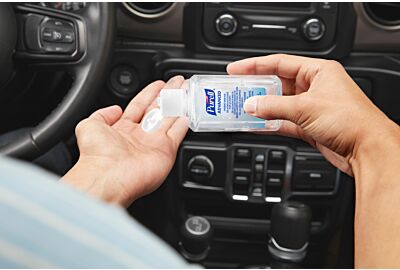Author: By Jim Arbogast, Ph.D. Hygiene Sciences and Public Health Advancements Vice President, GOJO Industries
Here at GOJO, we know hand sanitiser – and when it's best to use it. After all, we invented PURELL® hand sanitiser in 1988. Our team of scientists has been doing industry and public health-leading research on hand hygiene for decades. Our employees set hand sanitiser around the house, in their cars, handbags, and pockets… we give bottles to friends and family for the holidays. We know the key moments that we turn to our product. But maybe you aren't sure.
We've all heard so much about the importance of hand hygiene over the past three years – it has been a primary tool in keeping the public healthy during the pandemic. You've always been told to wash your hands when visibly soiled (like after handling raw meat or after working in the yard) – and you can see and feel that need, so we are all (hopefully) very comfortable washing our hands. It's our go-to way to clean our hands. When in doubt, wash your hands – and that is really important. But sometimes, when your hands aren't covered in food or grime, turning to a quality alcohol-based hand sanitiser is even better.
Take care of your hands
Washing your hands too often washes away lipids (natural fats that help protect your skin) faster than the natural recovery process of your body, causing dry or damaged skin. Hand sanitisers – at least well-formulated, high-quality ones like PURELL® hand sanitiser – are designed to leave effective skin conditioners behind while killing germs instantly. (Meaning they leave behind ingredients that help moisturise your skin.) That's part of the reason why alcohol-based hand sanitiser is required and preferred in healthcare settings – where an active caregiver cleans their hands more than 100 times per day!¹
Picking the right-hand sanitiser plays an important part in keeping your hands healthy – just like other key parts of your hand care efforts – like handwashing, wearing gloves when you wash your dishes or go outside in cold weather, plus using hand lotions occasionally during the day and especially before bed. Then your hands won't be so dry. (Read my colleague's blog post for more: “Dry Hands? Don’t Blame Your Hand Sanitiser”)
So, when should I use hand sanitiser?
The WHO recommends using an alcohol-based hand sanitiser with at least 60% alcohol² when soap and water are not readily available, but when are those moments? Here are some examples of key moments when you could turn to hand sanitiser (remember, please wash your hands if you can see food/soil/grime on them and after going to the bathroom). This list may seem long, but everyone should be washing or sanitising their hands 10-20 times in a typical day, and below are some of the key times that should happen. Using hand sanitiser is a convenient option to ensure you're practising good hand hygiene and killing germs on your hands that may cause illness.
Using hand sanitiser at home
- After blowing your nose, coughing, or sneezing
- Before applying makeup or adjusting your contacts
- After touching things in your everyday life that are likely to have germs that can make you sick:
- taking out the garbage
- handling dirty laundry
- touching pets
- changing a diaper (without visibly soiling your hands)
- caring for someone who is ill
- Before eating
- While you're preparing a meal (instead of constantly washing your hands, save it for when your hands are visibly dirty – like after handling raw meats or fresh fruits and vegetables that need rinsing)
- As soon as you get home after being in public spaces
Using hand sanitiser in public
- When entering and exiting a public place
- When you get into your car after being in public spaces
- Before eating or touching your face
- After touching surfaces commonly touched by others
- handrails and door handles
- lift buttons
- shopping trolleys
- self-service kiosks and payment screens
- petrol handles
- sports or gym equipment
- shared kitchens (fridge doors, coffee pots, etc.)
- shared workspace/classroom surfaces (keyboards, mice, copy machines, phones, etc.)
- condiment counters and waste areas
- hand bars/poles in public transit (underground, buses, trains)
- seat belt buckles in public transit and aeroplanes
- aeroplane tray table/latch, airport security trays
- children’s playgrounds
- restaurant menus
Have hand sanitiser available in your car and carry it on you, so you have it when you need it – plus, you can use your preferred brand and formula and know that while you're killing germs, you're also caring for your hands. Perhaps most importantly – reduce the risk of bad germs entering your personal spaces by using hand sanitiser when you get into your car and then again when you arrive home.
How to use hand sanitiser
When applying hand sanitiser, remember to use enough to thoroughly wet your hands (about the size of a pound), rub your hands briskly until dry – and don't forget your fingertips, thumbs, and between your fingers. This should take around 15-20 seconds with a well-formulated product.
¹ Boyce, J., Polgreen, P., Monsalve, M., Macinga, D., & Arbogast, J. (2017). Frequency of Use of Alcohol-Based Hand Rubs by Nurses: A Systematic Review. Infection Control & Hospital Epidemiology, 38(2), 189-195. doi:10.1017/ice.2016.247
²https://www.nipcm.scot.nhs.uk/web-resources-container/sicp-literature-review-hand-hygiene-surgical-hand-antisepsis-in-the-clinical-setting/













